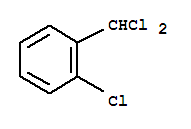| Identification |
| Name: | Benzene,1-chloro-2-(dichloromethyl)- |
| Synonyms: | Toluene, o,a,a-trichloro- (8CI); 1-Chloro-2-(dichloromethyl)benzene;2-Chlorobenzal chloride; 2-Chlorobenzylidene chloride; o,a,a-Trichlorotoluene; o-(Dichloromethyl)chlorobenzene;o-Chlorobenzal chloride; o-Chlorobenzylidene chloride; a,a,2-Trichlorotoluene |
| CAS: | 638-49-3 |
| EINECS: | 211-340-6 |
| Molecular Formula: | C7H5 Cl3 |
| Molecular Weight: | 116.18 |
| InChI: | InChI=1S/C6H12O2/c1-2-3-4-5-8-6-7/h6H,2-5H2,1H3 |
| Molecular Structure: |
 |
| Properties |
| Transport: | UN 1109 3/PG 3 |
| Melting Point: | -73.5 |
| Flash Point: | 83 °F |
| Boiling Point: | 132 °C(lit.) |
| Density: | 0.884 g/mL at 25 °C(lit.) |
| Refractive index: | n20/D 1.399(lit.) |
| Specification: |
1.Reactivity Profile: N-Amyl formate (CAS NO.638-49-3) is an ester. Esters react with acids to liberate heat along with alcohols and acids. Strong oxidizing acids may cause a vigorous reaction that is sufficiently exothermic to ignite the reaction products. Heat is also generated by the interaction of esters with caustic solutions. Flammable hydrogen is generated by mixing esters with alkali metals and hydrides.
2.Health Hazard :May cause toxic effects if inhaled or absorbed through skin. Inhalation or contact with material may irritate or burn skin and eyes. Fire will produce irritating, corrosive and/or toxic gases. Vapors may cause dizziness or suffocation. Runoff from fire control or dilution water may cause pollution.
3.Fire Hazard :Highly flammable: Will be easily ignited by heat, sparks or flames. Vapors may form explosive mixtures with air. Vapors may travel to source of ignition and flash back. Most vapors are heavier than air. They will spread along ground and collect in low or confined areas (sewers, basements, tanks). Vapor explosion hazard indoors, outdoors or in sewers. Runoff to sewer may create fire or explosion hazard. Containers may explode when heated. Many liquids are lighter than water.
|
| Report: |
Reported in EPA TSCA Inventory.
|
| Packinggroup: | III |
| Flash Point: | 83 °F |
| Safety Data |
| |
 |